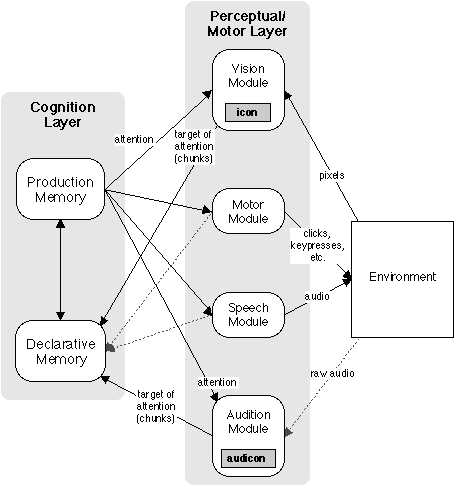
| RPM Theoretical Notes |  |
||
| chil home > projects > ACT-R/PM > | |||
Some notes on the design and functioning of ACT-R/PM.
ACT-R/PM is a computational theory of cognition and human performance. The cognitive part of the theory is based on the production system/Bayesian network theory of cognition implemented as ACT-R.
The perceptual-motor system is conceptualized as a layer between cognition (which is simply ACT-R's procedural and declarative memories and mechanisms) and the external environment. That is, the environment does not directly provide inputs to cognition, nor can cognition directly influence the environment. Communication between cognition and the outside world is mediated by the perceptual-motor capabilities of the system.
The Perceptual-Motor layer is made up of "Modules" that handle various aspects of perception and action. The Vision Module handles all vision-related processing, such as maintaining a visual icon and shifting attention. The Motor Module is responsible for preparing and executing basic motor actions, in particular, those involving the hands (especially key presses and mouse movements). The Speech Module is responsible for speech output, and the Audition Module is responsible for hearing. The figure below depicts the system configuration.

Productions cause shifts of attention and motor action initiation, and the perceptual-motor modules keep the cognition layer informed through the production system's declarative memory. The environment can be a simulated one, or the same one with which human subjects interact (assuming the human experiments are implemented in Macintosh Common Lisp).
The Vision Module encapsulates and extends the older Visual Interface, while the Motor Module is borrowed largely from EPIC (as described in Kieras & Meyer 1996). The Speech Module and the Audition Module are still quite rudimentary, though they do provide the capabilites necessary to model a great many results in those areas.
The Cognition Layer and the perceptual-motor Modules work in parallel with one another--that is, it is possible for ACT-R/PM to shift visual attention while retrieving a memory trace while clicking the mouse. Coordinating parallel activity like this can be difficult, but the benefits of such parallel activity can be substantial, particularly in high-performance multiple-task situations.
| People Facilities Research Projects Miscellany Search | Home |
Last modified 2005.01.26